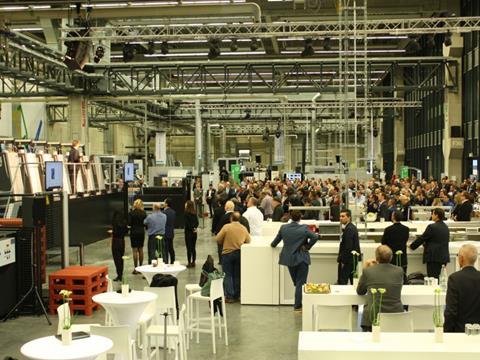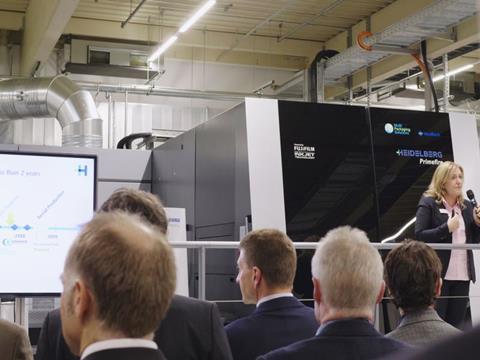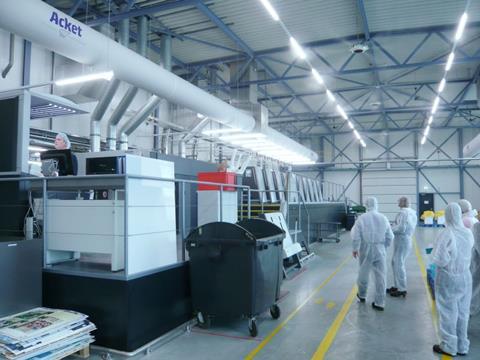
More than 300 visitors from around the world and over 40 international trade journalists including Elisabeth Skoda from Packaging Europe, attended the Packaging Day hosted by Heidelberger Druckmaschinen AG (Heidelberg) at its Wiesloch-Walldorf plant at the beginning of November.
The “Pushing the Future in Packaging” event showcased the latest solutions and technologies for packaging printing. The aim of these solutions is to increase the efficiency of all processes through intelligent networking and automation. This applies both to printing high-volume standard packaging as well as highly embellished folding cartons in the luxury segment.
Packaging printing is the strongest growing segment in the print media industry. Annual growth rates of around three percent are expected in the coming five years, and around 20 percent for digital printing. Heidelberg announced a broad-based product campaign for this market at drupa 2016, which is now being implemented consistently – in both offset and digital technology.
As key note speaker, Steffen Schnizer, Managing Director of Multi Packaging Solutions in Obersulm near Heilbronn, emphasized that demand from brand owners for exclusively finished packaging is on the increase. Nowhere is this truer than in the cosmetics and perfume industry. Purchase decisions are frequently made at the point of sale, where high-quality packaging guarantee the necessary attention.
He underlined the opportunities of smart packaging as a media channel. "The unmet needs of consumers go beyond the single product. Packaging can be a means to reach out to the consumer and become a social network in itself, hosting advertisements or offer complimentary products and redefine consumer centricity.”
“Heidelberg not only offers its customers the widest range of products for packaging output, but is also the clear market and technological leader in this area,” emphasised company CEO Rainer Hundsdörfer at the opening of the Packaging Day.
Stephan Plenz, member of the board digital technology at Heidelberg, highlighted the importance of pushing innovation in the packaging industry in a world where customer needs and production processes are continuously changing.
“The nature and functionality of printed products is transforming. Cost pressure keeps growing. Run lengths vary and updates make the products more timely and relevant. Automation as well as a low-touch and no-touch workflow reduces time and costs and boosts productivity. Companies have to deal with environmental pressures and sustainability remain important, also in the view of continuing globalisation.”

More than 300 presses with the Push to Stop concept delivered to customers
Striving to deliver exclusive design, look and feel packaging for end customers also makes the production process itself more complex and job changes more frequent. With its Push to Stop philosophy based on autonomous and navigated processes, Heidelberg is unlocking productivity potential that was previously beyond reach. The end result is predictable, user-independent productivity that enables cost-effective production, particularly with ever decreasing runs lengths and increasing levels of embellishment. This was demonstrated during the Packaging Day using the example of a Speedmaster XL 106-8+LYYL with cold foil module. The task? To change over from the current job, a five-color perfume box with cold foil and a combination of special matt and relief coating to a similarly challenging job. After just seven minutes, the first good sheet from the new production run was available. Consumables from Heidelberg’s own Saphira range were used for these special applications. Navigated printing was presented live for the first time in large format on a Speedmaster XL 145. Changing from a classic large-format, high-volume job with a substrate of 0.45 mm to a heavy board with a thickness of 1.5 mm took less than four minutes, without the need for any tools. The printing technique shown was direct printing on solid board. This material is widely used in the packaging market for foodstuffs or point of sale displays.
Very different technologies for very different requirements
How navigated printing is making production even more efficient, especially for very short runs, was demonstrated on the Speedmaster XL 75-8+LYYL with Anicolor technology. Three typical packaging jobs of the kind found in any pharmacy were printed: pharmaceutical cosmetics, over-the-counter medicines, and drugs that require a prescription. These jobs have different requirements, which need to be implemented in an economical way. Three different technologies were used on the Speedmaster XL 75 for this: Anicolor technology, which delivers fast and perfect inking for short runs with minimal start-up sheets; UV technology, which delivers enormous substrate diversity, special effects, and of course an instantly dry sheet; and finally the Multicolor workflow, in which almost all the required spot colours can be generated from seven colours.
In the area of postpress, three special products were presented under the motto “100 Percent Postpress Packaging” to demonstrate that Heidelberg offers the entire process chain with die-cutting, gluing, embellishing and product verification. The first product was the Promatrix 106 FC, a hot-foil embossing machine for embellishing cosmetic packaging, with for example metallic accents. The second product was the Promatrix 106 CSB, a die-cutter with die-cutting, stripping, and blanking function. This machine is ideal for further processing of foodstuffs, medicines, and household products. The third and final product was the Diana Eye 55 offline inspection system for reliable verification of the completeness of information and consistent quality of the cartons.
Future trends round off the Packaging DayThe Packaging Day was rounded off with various workshops. The “web-to-pack” topic addressed the question of how the “web-to-print” success model for commercial printing can also be applied to packaging, the prerequisites for this, and where the added value lies. Another workshop presented solutions within the Prinect Packaging workflow, and discussed the prerequisites for automated production of the entire manufacturing process within the packaging market.
The day after the Packaging Day, over 70 customers from 40 major European packaging manufacturers had the opportunity to see the future solutions for themselves during a visit to the Heidelberg customer Multi Packaging Solutions in Obersulm near Heilbronn.
“For a long time, digital printing presses were not able to meet our customers’ high standards for quality and color fidelity,” points out Multi Packaging Solutions Managing Director Steffen Schnizer. “The Primefire 106 from Heidelberg meets these requirements.” The manufacturer of high-quality folding cartons is the first customer to print commercially on the Primefire 106. The worldwide demand for this press is high, and production in Wiesloch-Walldorf is at full capacity for the next two years.

During a subsequent press tour, Heidelberg used the example of Acket Drukkerij Kartonnage in Oss in the Netherlands to show how significantly navigated printing can affect the efficiency and therefore the profitability of a packaging printer. Among the machines in Acket’s press room are three Heidelberg Speedmaster XL 106, the latest of which is equipped with Push to Stop technology. Owner Tom Acket constantly monitors the performance of his machines and compares them against benchmark figures. “In combination with shorter makeready times, the new Speedmaster XL 106 and Push to Stop allowed us to increase our productivity by 20 percent,” he says.
Smart Packaging Solutions in the Belgian city of Meer uses a Speedmaster XL 162-5+L for its printing needs. The company services a very special segment in packaging printing: solid board transport boxes for fruit and vegetables, which are grown in large quantities in the nearby Belgian and Dutch greenhouses. Furthermore they do have customers in the meat-processing industry and in the flower industry. The challenge here is that the cartons used as the substrate are extremely thick at up to 1.5 mm, and many presses fail to achieve high net production speed. The Speedmaster XL 162 can handle this with ease thanks to its robust design, and reliably produces 13,000 sheets per hour. With the machine that was previously used the maximum was only 8,000. “We’ve been using the Speedmaster 162 for six months,” reports Plant Manager Marc Hopstaken, “and I couldn’t be happier.”
More info:





















